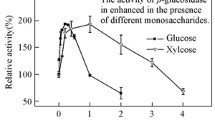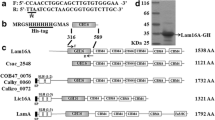Abstract
An extracellular β-glucosidase from Fusaruim solani cultivated on wheat bran was purified by only two chromatographic steps. The purified enzyme exhibited optimal temperature and pH at 60 °C and pH 5, respectively. The purified β-glucosidase behaves as a very large protein due to its high degree of glycosylation. More interestingly, the endoglycosidase H (Endo H) treatment led to 97.55% loss of its initial activity after 24 h of treatment. Besides, the addition of Tunicamycin (nucleoside antibiotic blocking the N-glycosylation first step) during the culture of the fungus affected seriously the glycosylation of the enzyme. Both treatments (endo H and Tunicamycin) strengthened the idea that the hyperglycosylation is involved in the β-glucosidase activity and thermostability. This enzyme was also shown to belong to class III of β-glucosidases (multi-specific) since it was able to act on either cellobiose, gentiobiose or sophorose which are disaccharide composed of two units of d-glucose connected by β1–4, β1–6 and β1–2 linkage, respectively. The β-glucosidase activity was strongly enhanced by ferrous ion (Fe2+) and high ionic strength (1 M KCl). The purified enzyme exhibited an efficient transglycosylation capacity allowing the synthesis of cellotriose and cellotetraose using cellobiose as donor.







Similar content being viewed by others
References
Roy D, Semsarilar M, Guthrie JT, Perrier S (2009) Cellulose modification by polymer grafting: a review. Chem Soc Rev 38:2046–2064
Klemm D, Heublein B, Fink HP, Bohn A (2005) Cellulose: fascinating biopolymer and sustainable raw material. Angew Chem Int (ed) 44:3358–3393
Eichhorn S, Dufresne A, Aranguren M, Marcovich NE, Capadona JR, Rowan S (2010) Review: current international research into cellulose nanofibres and nanocomposites. J Mater Sci 45:1–33
Saheb DN, Jog JP (1999) Natural fiber polymer composites: a review. Adv Polym Technol 18:351–363
Schulein M (2000) Protein engineering of cellulases. Biochim Biophys Acta-Protein Struct Mol Enzymol 1543:239–252
Soni R, Nazir A, Chadha BS (2009) Optimization of cellulase production by a versatile Aspergillus fumigatus fresenius strain (AMA) capable of efficient deinking and enzymatic hydrolysis of Solka floc and bagasse. Ind Crops Prod 31:277–283
Benhmad I, Boudabbous M, Yaîch A, Rebai M, Gargouri A (2016) A novel neutral, halophile Stachybotrys microspora-based endoglucanase active impact on β-glucan. Bioprocess Biosyst Eng 39:685–693
Dashtban M, Schraft H, Qin W (2009) Fungal bioconversion of lignocellulosic residues; opportunities and perspectives. Int J Biol Sci 5:578–595
Ben Hmad I, Abdeljalil S, Saibi W, Amouri B, Gargouri A (2013) Medium initial pH and carbon source stimulate differential alkaline cellulase time course production in Stachybotrys microspora. Appl Biochem Biotechnol 172:2640–2649
Guo Y, Yan Q, Yang Y, Yang S, Liu Y, Jiang Z (2015) Expression and characterization of a novel b-glucosidase, with transglycosylation and exo-b-1,3-glucanase activities, from Rhizomucor miehei. Food Chem 175:431–438
Fernández-Álvarez A, Elías-Villalobos A, Ibeas JI (2010) Protein glycosylation in the phytopathogen Ustilago maydis: from core oligosaccharide synthesis to the ER glycoprotein quality control system, a genomic analysis. Fungal Genet Biol 47:727–735
Sola RJ, Griebenow K (2009) Effects of glycosylation on the stability of protein pharmaceuticals. J Pharm Sci 98:1223–1245
Kazenwadel C, Klebensberger J, Richter S, Pfannstiel J, Gerken U, Pickel B, Schaller A, Hauer B (2013) Optimized expression of the dirigent protein AtDIR6 in Pichia pastoris and impact of glycosylation on protein structure and function. Appl Microbiol Biotechnol 97:7215–7227
Kern G, Kern D, Jaenicke R, Seckler R (1993) Kinetics of folding and association of differently glycosylated variants of invertase from Saccharomyces cerevisiae. Protein Sci 2:1862–1868
Raju TS, Scallon BJ (2006) Glycosylation in the Fc domain of IgG increases resistance to proteolytic cleavage by papain. Biochem Biophys Res Commum 341:797–803
Lehle L, Strahl S, Tanner W (2006) Protein glycosylation, conserved from yeast to man: a model organism helps elucidate congenital human diseases. Angew Chem Int Ed Engl 45:6802–6818
Stals I, Sandra K, Geysens S, Contreras R, Van Beeumen J, Claeyssens M (2004) Factors influencing glycosylation of Trichoderma reesei cellulases. I: postsecretorial changes of the O- and N-glycosylation pattern of Cel7A. Glycobiol 14:713–724
Adney W, Jeoh T, Beckham GT, Chou YC, Baker JO, Michener W, Brunecky R, Himmel ME (2009) Probing the role of N linked glycans in the stability and activity of fungal cellobiohydrolases by mutational analysis. Cellulose 16:699–709
Jeoh T, Michener W, Himmel ME, Decker SR, Adney WS (2008) Implications of cellobiohydrolase glycosylation for use in biomass conversion. Biotechnol Biofuels 1:1–10
Stals I, Sandra K, Devreese B, Van Beeumen J, Claeyssens M (2004) Factors influencing glycosylation of Trichoderma reesei cellulases II: N-glycosylation of Cel7A core protein isolated from different strains. Glycobiology 14:725–737
Hui J, Lanthier P, White TC, McHugh SG, Yaguchi M, Roy R, Thibault P (2001) Characterization of cellobiohydrolase I (Cel7A) glycoforms from extracts of Trichoderma reesei using capillary isoelectric focusing and electrospray mass spectrometry. J Chromatogr B 752:349–368
Hui J, White TC, Thibault P (2002) Identification of glycan structure and glycosylation sites in cellobiohydrolase II and endoglucanases I and II from Trichoderma reesei. Glycobiology 12:837–849
Christiansen M, Kolarich D, Nevalainen H, Packer NH, Jensen PH (2010) Challenges of determining O-glycopeptide heterogeneity: a fungal glucanase model system. Anal Chem 82:3500–3509
Evans C (1985) Properties of the β-d-glucosidase (cellobiase) from the wood-rotting fungus, Coriolus versicolor. Appl Microb Biotechnol 22:128–131
Gray BN, Yang H, Ahner BA, Hanson MR (2011) An efficient downstream box fusion allows high-level accumulation of active bacterial beta-glucosidase in tobacco chloroplasts. Plant Mol Biol 76:345–355
Zhao Z, Ramachandran P, Kim TS, Chen Z, Jeya M, Lee JK (2013) Characterization of an acid-tolerant β-1,4-glucosidase from Fusarium oxysporum and its potential as an animal feed additive. Appl Microbiol Biotechnol 97:10003–10011
Amouri B, Gargouri A (2006) Characterization of a novel β-glucosidase from a Stachybotrys strain. Biochem Eng J 32:191–197
Chen L, Li N, Zong MH (2012) A glucose-tolerant beta-glucosidase from Prunus domestica seeds: purification and characterization. Process Biochem 47:127–132
Mangas-Sánchez J, Adlercreutz P (2015) Enzymatic preparation of oligosaccharides by transglycosylation: a comparative study of glucosidases. J Mol Catal B Enzym 122:51–55
He H, Qin Y, Chen G, Li N, Liang Z (2013) Two-step purification of a novel β-glucosidase with high transglycosylation activity and another hypothetical β-glucosidase in Aspergillus oryzae HML366 and enzymatic characterization. Appl Biochem Biotechnol 169:870–884
Rather MY, Mishra S (2013) β-Glycosidases: an alternative enzyme based method for synthesis of alkyl-glycosides. Sustain chem process. doi:10.1186/2043-7129-1-7
Singh G, Verma A, Kumar V (2016) Catalytic properties, functional attributes and industrial applications of β-glucosidases. 3. Biotech 6(1):1–14
Rani V, Mohanram S, Tiwari R, Nain L, Arora A (2014) Beta-glucosidase: key enzyme in determining efficiency of cellulase and biomass hydrolysis. J Bioprocess Biotech. doi:10.4172/2155-9821.1000197
Dabek M, McCrae SI, Stevens VJ, Duncan SH, Louis P (2008) Distribution of β-glucosidase and β-glucuronidase activity and of β-glucuronidase gene gus in human colonic bacteria. FEMS Microbiol Ecol 66(3):487–495
Boudabbous M, Saibi W, Bouallagui Z, Dardouri M, Sayadi S, Belghith H, Mechichi T, Gargouri A (2016) Fast activated-charcoal prepurification of Fusaruim solani β-glucosidase for an efficient oleuropein bioconversion. Prep Biochem Biotechnol. doi:10.1080/10826068.2016.1201679
Laemmli U (1970) Cleavage of structural proteins during the assembly of the head of bacteriophage T4. Nature 227:680–685
Bradford M (1976) A rapid and sensitive method for the quantitation of microgram quantities of protein utilizing the principle of protein-dye binding. Anal Biochem 72:248–254
Saibi W, Gargouri A (2011) Purification and biochemical characterization of an atypical β-glucosidase from Stachybotrys microspora. J Mol Catal B: Enzym 72:107–115
Lin J, Ndlovu LM, Singh S, Pillay B (1999) Purification and biochemical characteristics of β-d-xylanase from a thermophilic fungus, Thermomyces lanuginosus-SSBP. Biotechnol Appl Biochem 30:73–79
Lineweaver H, Burk D (1934) The determination of enzyme dissociation constants. J Am Chem Soc 56:658–666
Kodama S, Tsujimoto M, Tsursoka N, Sugo T, Endo T, Kobata A (1993) Role of sugar chains in the in vitro activity of recombinant human interleukin 5. Eur J Biochem 211:903–908
Terashima M, Kubo A, Suzawa M, Itoh Y, Katoh S (1994) The roles of the N-linked carbohydrate chain of rice α-amylase in thermostability and enzyme kinetics. Eur J Biochem 226:249–254
Wyss D, Wagner G (1996) The structural role of sugars in glycoproteins. Curr Opin Biotechnol 7:409–416
Ulhoa C, Sankievicz D, Limeira PS, Peberdy JF (2001) Efect of tunicamycin on N-acetyl-L-D-glucosaminidase produced by Trichoderma harzianum. Biochim Biophys Acta 1528:39–42
Silva TM, Almeida F, Damásio A, Maller A, Michelin M, Jorge J, Hanna E, Roque-Barreira M, Terenzi H, de Lourdes Teixeira de Moraes Polizeli M (2010) Tunicamycin inhibition of N-glycosylation of a-glucosidase from Aspergillus niveus: partial influence on biochemical properties. Biotechnol Lett 32:1449–1455
Tiwari P, Misra BN, Sangwan NS (2013) Beta-glucosidases from the fungus Trichoderma: an efficient cellulase machinery in biotechnological applications. Biomed Res Int 2013:203735
Krisch J, Bencsik O, Papp T, Vágvölgyi C, Takó M (2012) Characterization of a b-glucosidase with transgalactosylation capacity from the zygomycete Rhizomucor miehei. Bioresour Technol 114:555–560
Yan TR, Lin HL (1997) Purification and characterization of a glucose tolerent b-glucosidase from Aspergillus niger CCRC31494. Biosci Biotechnol Biochem 61:965–970
Parry N, Beever D, Owen E, Vandenberghe E, Van Beeumen J, Bhat MK (2001) Biochemical characterization and mechanism of action of a thermostable b-glucosidase purified from Thermoascus aurantiacus. Biochem J 353:117–127
Wang Y, Xu Y, Li J (2012) A novel extracellular β-glucosidase from Trichosporon asahii: yield prediction, evaluation and application for aroma enhancement of cabernet sauvignon. J Food Sci 77:505–515
Saibi W, Gargouri A (2011) Hydroxyl distribution in sugar structure and its contributory role in the inhibition of Stachybotrys microspora b-glucosidase (bglG). Carbohydr Res 346:1848–1854
Saha B, Bothast R (1996) Production, purification, and characterization of a highly glucose-tolerant novel β-glucosidase from Candida peltata. Appl env microb 62:3165–3170
Speake B, Malley DJ, Hemming FW (1981) The effect of tunicamycin on secreted glycosidases of Aspergillus niger. Arch Biochem Biophys 210:110–117
Saibi W, Amouri B, Gargouri A (2007) Purification and biochemical characterization of a transglucosilating β-glucosidase of Stachybotrys strain. Appl Microbiol Biotechnol 77:293–300
Mallek-Fakhfakh H, Belghith H (2016) Physicochemical properties of thermotolerant extracellular β-glucosidase from Talaromyces thermophilus and enzymatic synthesis of cello-oligosaccharides. Carbohydr Res 419:41–50
Hansson T, Adlercreutz P (2001) Enhnced transglycosylation/hydrolysis ratio of mutants of Pyrococcus furiosus beta glucosidase: effect of donner, concentration, water content, and temperature on activity and selectivity in hexanol. Biotechnol Bioeng 75:656–665
van Rantwijk F, Woudenberg-van Oosterom M, Sheldon R (1999) Glycosidase-catalysed synthesis of alkyl glycosides. J Mol Catal B Enzym 6:511–532
Kono H, Kawano S, Tajima K, Erata T, Takai M (1999) Structural analyses of new tri- and tetrasaccharides produced from disaccharides by transglycosylation of purified Trichoderma viride β-glucosidase. Glycoconj J 16:415–423
Smaali I, Maugard T, Limam F, Legoy M, Marzouki N (2007) Efficient synthesis of gluco-oligosaccharides and alkyl-glucosides by transglycosylation activity of β-glucosidase from Sclerotinia sclerotiorum. World J Microbiol Biotechnol 23:145–149
Singhania RR, Patel AK, Sukumaran RK, Larroche C, Pandey A (2013) Significance of beta-glucosidases in the hydrolysis of cellulose for bioethanol production. Bioresour technology 127:500–507
Korotkova O, Semenova MV, Morozova VV, Zorov IN, Sokolova LM, Bubnova TM, Okunev ON, Sinitsyn AP (2009) Isolation and properties of fungal β-glucosidases. Biochemistry (Moscow) 74(5):569–577
Dekker RF (1986) Kinetic, inhibition, and stability properties of a commercial β-glucosidase (cellobiase) preparation from aspergillus niger and its suitability in the hydrolysis of lignocellulose. Biotechnol Bioeng 28(9):1438–1442
Acknowledgements
This work was supported by grants from the Ministry of Higher Education, Scientific Research and Technology, Tunisia. The authors would like to thank Ines Belhadj for helpful discussions and advices, Hajer Hassairi and Kamel Walha for their expert help in chromatographic analysis and finally Abdelmajid Dammak for his proof reading of the text.
Author information
Authors and Affiliations
Corresponding author
Ethics declarations
Conflict of interest
The authors declare that they do not have any conflict of interest.
Rights and permissions
About this article
Cite this article
Boudabbous, M., Ben Hmad, I., Saibi, W. et al. Trans-glycosylation capacity of a highly glycosylated multi-specific β-glucosidase from Fusarium solani . Bioprocess Biosyst Eng 40, 559–571 (2017). https://doi.org/10.1007/s00449-016-1721-7
Received:
Accepted:
Published:
Issue Date:
DOI: https://doi.org/10.1007/s00449-016-1721-7




